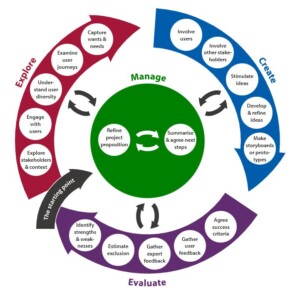The Inclusive Design Wheel helps to develop an inclusive mobility product or service, or to improve the inclusivity of an existing one.
What is it: The DIGNITY IDW process is a concept design process focused on developing inclusive mobility products and services. The process is described in the Inclusive Design Toolkit‘s section about inclusive design of transport services.
When to use it: The method is used in the design and development of mobility products and services. Ideally, it should be used from the start of a design project, but it can also be brought in partway through a product if required.
Flexibility: The IDW process can be used for both short- and long-term projects. It can be used throughout the design process.
Mostly QUANTITATIVE but some parts are QUALITATIVE
Time / Duration: The amount of time the IDW takes depends on the scale of the project, the required fidelity of the concept, and the type and amount of evidence required to show that the concept is effective. This can vary from a few weeks to several months or even years.
Cost: The IDW guides the concept design process, and so its cost primarily relates to the cost of the activities in this process. The specific activities and their cost will vary between projects depending on what is required in order to understand the need, develop concepts and gather supporting evidence.
Materials: The process requires standard office materials, as well as a system for managing the project and recording the outputs. The IDW design log is supplied to assist with the latter. This is currently a PowerPoint file, but other methods may be used for this purpose (e.g Miro boards, Teams, Dropbox, shared network drives).
Additional resources will be needed for specific activities within the IDW, e.g.:
- Workshops to support concept design typically work well in person in a room with lots of whiteboard space, flipcharts and post it notes. However, the need to run these activities remotely due to Covid led to increasing attempts to run these sorts of workshops online, using resources like Miro.
- Activities that involve working with end users may require specific resources like consent forms, and audio/video recording equipment, and secure storage facilities.
- Prototyping and sketching activities may require pens, pencils and lots of paper and cardboard.
- Virtual prototyping may require dedicated 3D modelling software or wireframing tools like Figma.
Expertise: HIGH.
Concept design requires expertise in both convergent and divergent thinking. Divergent thinking asks questions like “how else could we do this?”. Convergent thinking asks questions like “which of these approaches is the best?”
Concept design cannot be articulated as a set of instructions that can be methodically followed to guarantee a successful output. It requires a creative balance between structure and flexibility.
Developing concepts and embodying them as prototypes may require expertise in particular software applications that support these activities,
Understanding user needs and evaluating solutions may require expertise in working with users (e.g. co-creation workshops, observation, interviews, user trials).
Stakeholders involved: The IDW involves creating a stakeholder map and considering which stakeholders should be involved in the IDW process and in what capacity. The exact stakeholders will depend on the project. At the least, the design team and a sample of end-users are involved. Ideally, a wider range of stakeholders is involved to some extent.
Nº of participants: 6-10 participants is good for a co-creation workshop. The number of participants in other activities depends on the project.
The process is described in detail in the Inclusive Design Toolkit‘s section about inclusive design of transport services. This process description is based on the diagram below:

Main outcomes: A more inclusive mobility product or service.
The Explore phase of the IDW provides an understanding of the needs that should be met. The Create phase provides ideas, concepts and prototypes for addressing those needs. The Evaluate phase provides feedback on how well the concepts meet the needs and how they could be improved. The Manage phase guides the process of managing the team.
Tips / Remarks / Suggestions: The process is flexible and iterative, which brings challenges for file management and project management. An integrated design log is supplied as a PowerPoint file to help assist this, but the Explore, Create and Evaluate activities can also be implemented within an existing project and file management process.
Limitations of the method: Concept design can work best when it is slightly chaotic. However, the quality of the output may be limited if it is too chaotic, or too structured. Achieving the best outputs requires a balance of creativity and structure.